It’s good to know the rattlesnakes are out of hibernation. The best way to learn this is from your friendly neighborhood hiking blogger. The worst way is from the tips of their hypodermic fangs.
My way was in the middle: blundering about in an interesting rock formation at Joseph D. Grant County Park, taking one step too many and hearing that just-like-on-TV rattle, looking down and seeing a striped gray viper about a foot from my ankle, slithering off toward a hiding place where he rattled like crazy for another minute or so while my heart fell back down out of my throat after the “holy shit it’s a rattler” realization sank in.
This was my first rattlesnake run-in. I’m glad to have it out of the way, so now I’ll know the difference between what one might sound like and what it does sound like. There are always rattling noises on the trail, but there is only one rattlesnake rattle. Good to know, as they say.
More rattlesnake facts here, which includes these rattlesnake do’s and don’ts:
- First, know that rattlesnakes are not confined to rural areas. They have been found near urban areas, in river or lakeside parks, and at golf courses. Be aware that startled rattlesnakes may not rattle before striking defensively. There are several safety measures that can be taken to reduce the likelihood of startling a rattlesnake.
- Never go barefoot or wear sandals when walking through wild areas. Wear hiking boots.
- When hiking, stick to well-used trails and wear over-the-ankle boots and loose-fitting long pants. Avoid tall grass, weeds and heavy underbrush where snakes may hide during the day.
- Do not step or put your hands where you cannot see, and avoid wandering around in the dark. Step ON logs and rocks, never over them, and be especially careful when climbing rocks or gathering firewood. Check out stumps or logs before sitting down, and shake out sleeping bags before use.
- Never grab “sticks” or “branches” while swimming in lakes and rivers. Rattlesnakes can swim.
- Be careful when stepping over the doorstep as well. Snakes like to crawl along the edge of buildings where they are protected on one side.
- Never hike alone. Always have someone with you who can assist in an emergency.
- Do not handle a freshly killed snake, it can still inject venom.
- Teach children early to respect snakes and to leave them alone. Children are naturally curious and will pick up snakes.
OK, now these public service details have been aired, let’s look at some pictures from Monday’s hike (sorry, no pix of the snake, I was too busy being frozen in fear):
I started out at the Twin Gates Trail Head. Had some nice sky — was hoping for signs that wildflower season had arrived, but didn’t see much up this way. Saw lots of California poppies on the way to the park, though, so they’re out there.
I had to stop by and check out this old truck again. The doors are all bullet-riddled, as if Bonnie and Clyde had made their last stand right here.
I did see a few wildflowers … mostly buttercups, and a few of these purple lovelies (might be a checkerbloom, though I can’t say for sure).
After wandering around on the northeast end of the park, I headed down the road toward Bass Lake, where I wanted to take a few more pictures for a future column about Grant Ranch. There’s a little parking area a mile or so down the road where you can turn in, and crawl over a break in the fence designed to foil mountain bikers, and wander down toward the lake. I saw this rock formation and decided to check it out.
It’s where the rattlesnake and I had our little “hi, how are you” encounter.
How it looks from a distance. It had some tagging and graffiti on the rocks; perhaps cosmic justice will be visited upon the next youthful miscreants who run afoul of the resident rattler.
Bass Lake. Hmm, wonder if it has any bass in it.
With my Bass Lake visit over, I stopped by Grant Lake to see if anything photogenic was happening. If you look real closely at the bottom of this picture, you’ll see a couple Canada geese. I feel no compunction about annoying Canada geese, because they need to be reminded that they are migratory birds and that nice ponds like this one were not put here for their comfort and convenience. Fly on, geese, I say.
One of them obliged when I got a bit too close.
(Incidentally: mad props to Fedak for donating his old camera to the blog.)

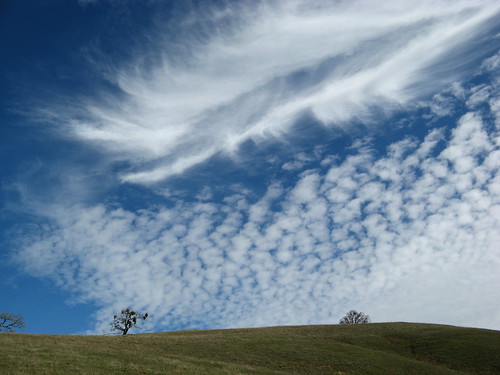

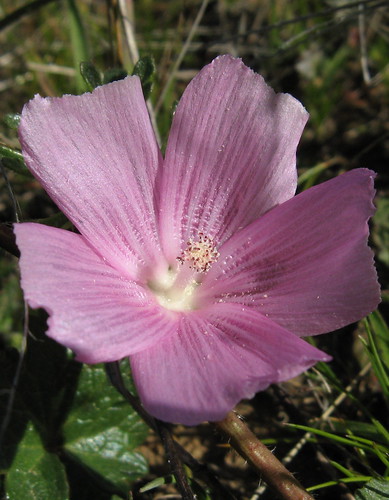
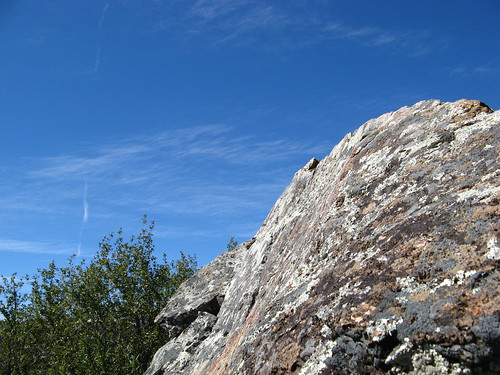
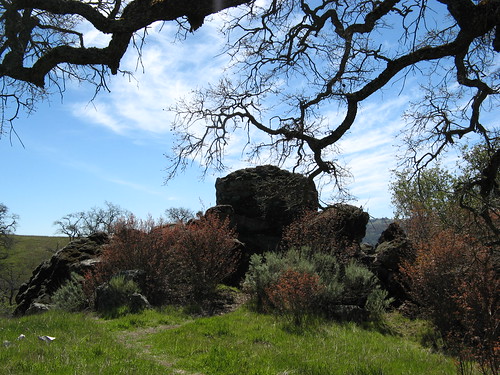
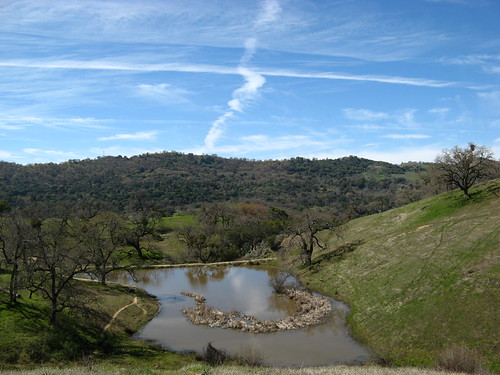
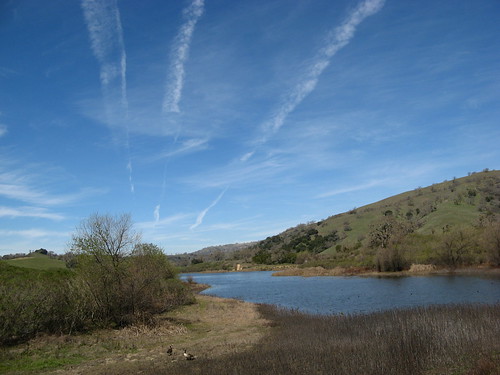
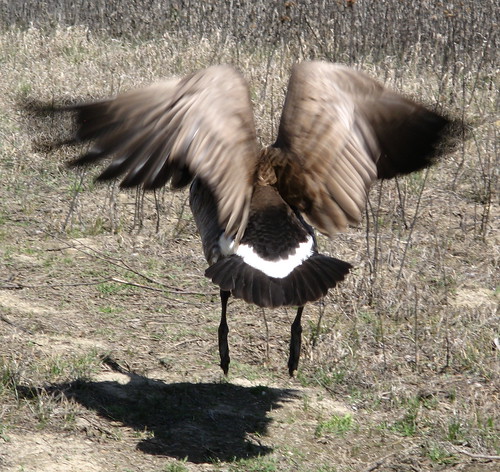
Tom,
Good story, great opening shot! Can’t believe you’ve never come upon a rattler before!
See my Tennessee Valley opening paragraph for my own close encounter with one.
Also, this Sunol posting (first pic) demonstrates what you were saying – they can swim!
http://gambolinman.blogspot.com/2007/04/sunol-regional-wilderness-favorite.html
I have come across a few rattle snakes were I saw them before I heard (or stepped on them). The first in the Sierra foothills above Auburn when I was in the scouts, as I stepped down, something didn’t look right so I hopped and avoid stepping on a small snake. Then in the San Rafael Wilderness north of Santa Barbara, I was climbing out a canyon one morning as a snake was just starting to warm himself on the path. Hopping over a snake on a steep grade, with a full pack is memorable.
Saddly, I haven’t seen a rattlesnake in about 15 years.
I came a half-step of stepping on one last June. It was early in the morning (still half asleep) as I was walking I briefly looked at it, and thought “funny, someone left their belt here” two more steps it HIT me what I was looking at/extremely close too.
Photo: http://farm2.static.flickr.com/1378/543273869_75ea3a20b5_b.jpg
He didn’t rattle. My guess is that it was so early he was still too cold to move. The rest of my hike was in a little fear, and day dreaming what I would have done if I stepped right in the middle of him. I’ve always read “stay calm, and get to the hospital ASAP” not sure how calm I’d be in this moment.
Great read, Tom. Also thanks for the refresher of the “do’s and dont’s” it’s important an important reminder.
Happy Trails,
Larry
I have only seen one rattler in the wild and that was way back in October of 06, many a year ago now it seems, ah those were the days. In this case I saw it on the road coming down from the main entrance at Henry Coe as I was driving home. I managed a few shots of it from inside the safety of my car, picture evidence at the very bottom of the page here:
http://web.mac.com/cynthial1952/iWeb/Site/Soda%20Springs%20Trail.html
It was just sitting in the middle of the road all coiled up and I knew it was a rattler the instant I saw it. It crawled off the road and down the hill before I left and so I am glad no car killed it on this day. And I am even more glad not to be bitten by it while still having a chance to see it. It was sure a fiesty snake though striking all the while at my car. Yikes!
They don’t always rattle… I was off-trail once, walking along a cow path,
when I heard a peculiar hissing noise. I thought it might be air escaping
from a deflating cow pie or something. I turned around and started to walk
back and nearly stepped on it! I sure jumped back in a hurry.
I’ve also heard that rattlers in some regions have learned not to rattle, as
doing so gets them whomped with a shovel.
The lesson is to always watch where you place your feet.
Anon: I had to completely rewrite the intro to this post for just that reason: I was all “rattlers aren’t so bad, after all they do give out a warning” … then when I was assembling the do’s and don’ts list I saw that they don’t always rattle.
I’ve almost stepped on a rattler twice, and neither time did I hear any rattle. Both times were in spring, and both times the snake was right in the trail concealed amongst rocks. Once was in Portola on Peter’s creek trail. My peripheral vision just picked up this coiling shape just before I stepped over some rocks. The snake was sunning on the rocks in the middle of the trail. I froze in mid-step and backed away slowly. It stuck it’s head up as if sleepy, to look around to see what was happening. I had to jump up and down and make noise to coax it off the trail in order to pass. The other time was in Yosemite on snow creek trail, again the snake was concealed amongst rocks. No rattle, it seemed to sense vibration or something and made a quick move away and I froze. After it calmed down I was able to slowly ease by and managed this picture as it slithered away.
http://www.flickr.com/photos/85908626@N00/127644997/in/set-72057594105804952/
These were both pacific coast rattlers. One of the more docile varieties
I’ve never seen a rattlesnake in the ‘wild’ though I almost stepped on one during a stroll with my toddler son in the Heathers Farm Park, Walnut Creek.
yessir, it is always good to pay attention in the woods and elsewhere as well. I haven’t seen any rattlers yet this year up in Annadel (Santa Rosa, my home park), but last spring/summer I came across 5, most of them in the shadow lines around trees. a couple of big ones were just lying right on the trail.
a friend of mine killed one in his garage with a shovel last August; they are around. as for the woods, well, I think that if you actually look for them, assuming that you know where they are likely to be, that you will find rattlers in most, if not all, north bay parks/rec areas. which means that you will very likely see them long before they nail you and so there won’t ever need to be a “run in”. the truth is, if I don’t see a few snakes during the season I begin to suspect that I’ve begun slacking, and sure enough, as soon as I get back to paying attention to the environs, snakes start showing up. funny how that works.
great pics, by the way, Tom.
john
In my lifetime I’ve stepped directly onto 2 rattlers.
I couldn’t tell you how many I’ve killed.
I grew up watching for them.
As I got older I stopped killing them as often as I used to.
Any more I normally just go my way and let them go theirs.
Anymore the only time I usually kill them is if they are around kids or animals I’m worried about.
In most instances a rattler won’t even attempt to strike. It will go away from you if you just give it the opportunity to do so.
The most important things to remember is no quick movements around the snake and to watch where you put your hands and feet when walking or climbing.
-It’s also a good idea to know where they’re likely to be, but that has a lot of variables (cover, sun, temperature, etc.) and I don’t feel like writing a book.
One for all you snake charmers: ever eaten one?
Ever eaten rattlesnake? I have, at the Rattlesnake Roundup in Walnut Springs, Texas. I asked what it tasted like and sure enough the cook said “Tastes like chicken”. Well, I thought it tasted more like sardines than any chicken I ever tasted, fried, baked, bar-b-qued or burnt.
Rattlesnakes are more common than not at Rancho San Antonio and I have caught more than my fair share along with a few California King Snakes and Gopher Snakes all relativly harmless and more apt to slither away than stay and strike!!!!
I ride my mountain bike every other day. I frequent Sunol Ohlone Wilderness, Pleasanton Ridge and Las Trampas. I have yet to see a rattle snake in Las Trampas, I have seen one at the Pleasanton ridge. As I start my climb at the Ridge I almost always see snake tracks on the fine powdered dirt from large snakes, either a Gopher,King or Rattle Snake, the most interesting part is that I almost never see a bike track running over the snake track, typically you have a rider going up every 15-30 minutes. Ok, if your really interested in seeing a Rattle snake, or if you want to know where NOT to go hiking because you are deathly afraid of rattlers read this. Sunol Ohlone Regional wilderness in Sunol, Little Yosemite to be exact just up from those beautiful water falls is home to an abundance of these reptiles. There is a seasonal creek bed just up from the falls where these guys love to sun themselves. I have photographed many of these snakes from 8 inches long to 3 feet. Most of them laying out on the small pebble size rocks, one I saw was under those green cattle gates (the ones cattle wont walk on) I stopped walking down there with my niece and nephews. I no longer let my golden retriever off the leash there. I also witnessed the aftermath of a 100lb Labrador being carried by a 90lb woman in tears suggesting her dog had just been bitten by a rattler down stream from the falls. This is a beautiful place, you may never see one, but the habitat is just right for these guys. I still go there but, I really pay attention. I have a much better time on cold days.